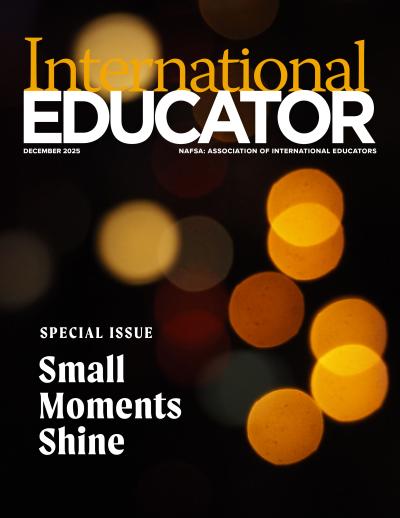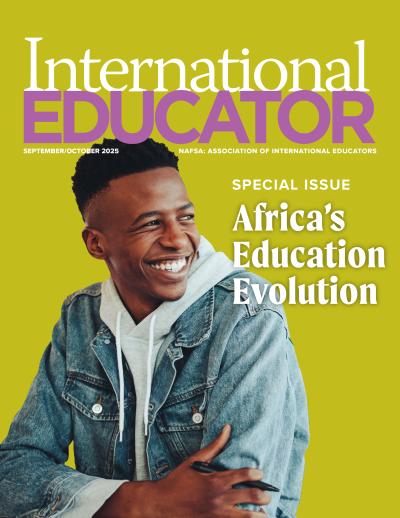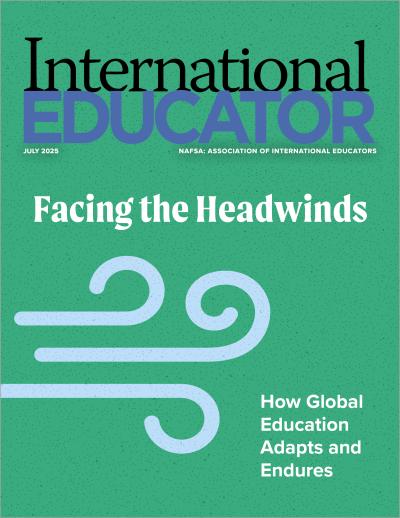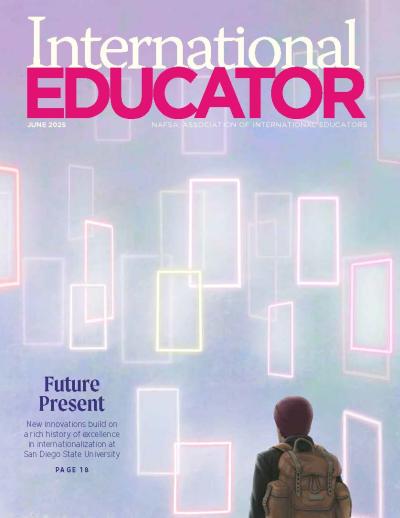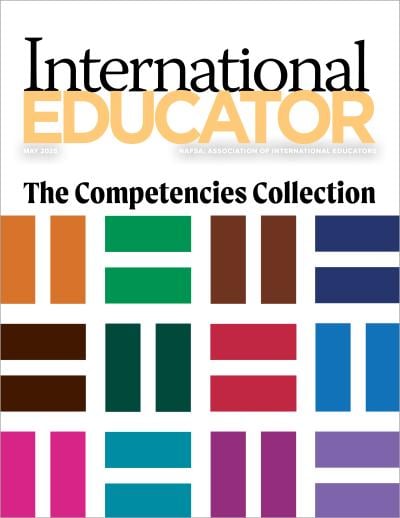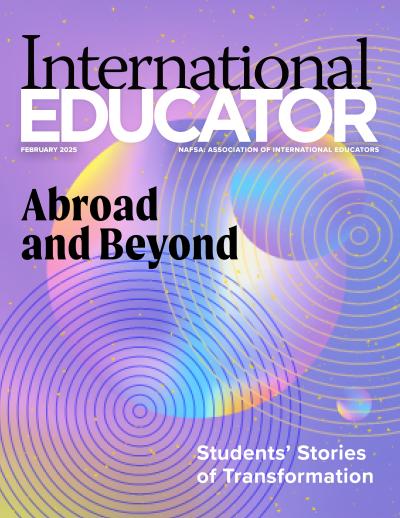Excellence in Action: Proven Models for Impactful Partnerships

Over the past two decades, recipients of NAFSA's Senator Paul Simon Award for Campus Internationalization have demonstrated that partnerships are at the core of successful internationalization. These institutions illustrate how intentional and reciprocal partnerships—whether they're global research collaborations, engagement with local and global business communities, study abroad consortia, or community-based initiatives—can transform higher education. Simon Award recipients offer insights into how effective partnerships are conceived, managed, and leveraged to serve students and communities.
Building Partnerships Across Borders
Higher education institutions that are located close to national borders can transform geographic proximity into strategic advantage by creating partnerships that address regional, binational, and global challenges.
San Diego State University's (SDSU) (2025 Comprehensive Award) annual RE:BORDER Conference brings together academics, business leaders, and government officials from Mexico and the United States to address critical transborder issues. The conference has generated concrete outcomes: In 2023, engineering teams from SDSU and Instituto Tecnológico de Tijuana received a $5,000 seed grant, which in turn led to a six-figure grant from the San Diego Foundation for developing water treatment technologies. The larger grant enabled labs at both institutions to develop standardized procedures for water pollution testing, allowing samples to be analyzed in either country.
Another institution, the University of Arizona (U of A) (2025 Comprehensive Award), maintains a comprehensive portfolio of cross-border engagement, including several public health initiatives that serve border populations and a training program for Mexican diplomats in U.S. law, which is administered through a collaboration between the College of Law and the Matías Romero Institute, Mexico's diplomatic academy. The program has trained more than 150 Mexican diplomats over the past seven years, enhancing consular services and strengthening binational relations.
U of A is also a member of the Arizona-Sonora Interuniversity Alliance (AISA), a regional consortium comprised of the leading research institutions in Arizona and the Mexican state of Sonora, focused on addressing regional cross-border issues. Since its founding in 2017, AISA has facilitated over 30 joint research projects, engaged more than 60 Mexican scholars in collaborative research, and established permanent research clusters contributing to scientific and innovation efforts in the transborder region.
Leveraging Local Communities for Global Engagement
Partnerships don't have to be international to enrich internationalization efforts; many Simon Award recipients take advantage of local resources and relationships to globalize their campuses.
Houston, Texas, for example, has the third-largest concentration of consulates in the United States. Prairie View A&M University (2024 Comprehensive Award) capitalizes on this international presence in the local community through its Consular Tour Program, which gives students passport-free exposure to global perspectives and the world of international diplomacy. Through the tours, students learn about diplomatic roles, engage in discussions on development and tourism, and gain a unique perspective on international relations.
Within the University of Pittsburgh's (2017 Comprehensive Award) Cathedral of Learning, a 42-floor skyscraper that serves as an educational hub on campus, 31 Nationality Rooms celebrate and honor the cultural heritages of the local community.
Since the first Nationality Room was completed in 1938, the university has worked hand in glove with members of the local community on each room's development and management. Committees of community members from the relevant heritage groups provide funding for construction and maintenance of the rooms as well as financing for study abroad scholarships to the respective countries—deepening and enriching connections between university and local and global communities.
Turning Sister Cities into Academic Partners
Municipal relationships provide ready-made diplomatic infrastructure for sustainable academic partnerships. By leveraging these established civic connections, institutions can build upon existing cultural and governmental relationships to create meaningful educational exchanges and programs that benefit both communities.
In Texas, San Antonio's Sister City program became the foundation for the Alamo Colleges District (2024 Comprehensive Award) to establish educational partnerships spanning six countries: Germany, India, Japan, Mexico, Namibia, and Panama.
Similarly, the sister cities agreement between Oxford, Ohio, and Differdange, Luxembourg, served as the basis for new international education initiatives at Miami University (2019 Comprehensive Award). Students from Miami's College of Education can participate in teaching placements in Differdange, where they earn credit for helping facilitate summer camps for English language learners. The sister cities relationship has also led to the creation of scholarships for Luxembourgish students to study in Ohio.
Recently, the university partnered with the city of Differdange to expand student housing options, allowing the university to increase enrollment of study abroad students from about 300 students a year to around 500 students.
Addressing Local Industry and Workforce Needs
Collaboration with partners in local and global business communities can also be fruitful. These initiatives can serve to identify regional workforce challenges and create pathways for innovative solutions to address them.
Auburn University (2024 Comprehensive Award) capitalized on the more than 60 Korean companies—including Hyundai and Kia—located within an hour of campus by establishing the Auburn-Keimyung Korea Center to bridge cultural gaps and support workforce development. The center coordinates an exchange with seven Korean universities where students take courses before completing internships in the automotive industry.
Similarly, Alamo Colleges District (2024 Comprehensive Award) developed a strategic approach to address local healthcare workforce shortages by partnering with Tecmilenio University in Mexico and Methodist Healthcare System. Together, these organizations developed the International Nursing Pathway, a program that offers specialized microcredentials to prepare Mexican nurses to pass U.S. licensing examinations, creating a direct pipeline of skilled healthcare professionals to meet the local hospital's employment needs.
Investing in Faculty Collaboration to Generate External Funding
Providing targeted seed funding and creating structured opportunities for faculty collaboration can support the development of sustainable research partnerships that attract significant external funding and generate new knowledge.
The University of Georgia (UGA) (2018 Spotlight Award and 2025 Comprehensive Award) pioneered a "research accelerators" initiative, employing seed funding and faculty workshops that bring together educators from UGA and partner institutions to foster the development of joint research proposals. The pilot was launched in Brazil with the Minas Gerais State Research Foundation and several Brazilian institutions, and the initiative has since been replicated with the University of Liverpool. UGA's seed funding initiatives like these have resulted in more than $25 million in external funding.
The University of North Carolina-Chapel Hill (2016 Spotlight Award) built its research approach on island sustainability in the Galápagos Islands of Ecuador around faculty relationships—geography and environment professor Stephen Walsh's research trips to Ecuador led to the Galápagos Science Center, established in 2011 with Universidad San Francisco de Quito for interdisciplinary research on population, health, and environment, focused on building local capacity in conjunction with fragile marine, terrestrial, and human ecosystems.
Pooling Resources Through Consortia
Consortia allow institutions to pool resources and provide opportunities that would be difficult for individual institutions to develop alone. These collaborative networks enable colleges and universities to share curricula, facilities, and program infrastructure across borders while reducing individual costs and creating richer educational experiences that benefit students from multiple institutions.
Kirkwood Community College (Kirkwood) (2019 Comprehensive Award) participates in the Global Education Network with the Box Hill Institute in Australia, the Southern Alberta Institute of Technology in Canada, and the Institute of Technical Education (ITE) in Singapore. Through the initiative, the institutions share vocational and technical curricula in the areas of auto technology, welding, graphic design, veterinary technician, and early childhood education, among others. The collaboration has resulted in shared curriculum and facilities like medical simulation labs that Kirkwood modeled after ITE's programs.
Brown University (2019 Comprehensive Award) leads the Consortium for Advanced Studies Abroad (CASA), made up of 12 research institutions, including the University of Melbourne and Trinity College Dublin. Before CASA, consortium members were running separate programs in the same cities; by working together they achieve a broader impact while sharing costs and resources.
Choosing Depth over Breadth in Strategic Partnerships
Cultivating deep, multifaceted relationships in a specific region or with carefully selected partners that align with institutional mission and strengths yields more meaningful outcomes than numerous shallow memoranda of understanding.
St. Lawrence University (St. Lawrence) (2018 Comprehensive Award) demonstrates this approach through its strategic focus on East Africa, where the school has developed a comprehensive partnership with Kenya—a partnership that spans academic, cultural, and scholarly domains. What began as a five-acre Nairobi campus has expanded to a standing Swahili scholar exchange program that has engaged more than 2,300 students since its founding in 1974. Since the early 1980s, St. Lawrence has also provided two full scholarships to Kenyan students on an annual basis, supporting decades of educational exchange.
The College of William & Mary (2016 Comprehensive Award) similarly transformed its strategic partnership with the University of St Andrews in Scotland, converting a 25-year study abroad relationship into a joint-degree program with six academic tracks where cohorts of approximately 60 students complete two years at each institution.
Tying It All Together
Across these diverse examples, a common thread emerges: Successful partnerships require intentional strategy, sustained commitment, and reciprocal benefit. Whether institutions are leveraging geographic proximity, local resources and relationships, or aligned academic strengths, the most impactful collaborations are those built on mutual goals and shared investment in student success. •
NAFSA Resources
About International Educator
International Educator is NAFSA’s flagship publication and has been published continually since 1990. As a record of the association and the field of international education, IE includes articles on a variety of topics, trends, and issues facing NAFSA members and their work.
From in-depth features to interviews with thought leaders and columns tailored to NAFSA’s knowledge communities, IE provides must-read context and analysis to those working around the globe to advance international education and exchange.
About NAFSA
NAFSA: Association of International Educators is the world's largest nonprofit association dedicated to international education and exchange. NAFSA serves the needs of more than 10,000 members and international educators worldwide at more than 3,500 institutions, in over 150 countries.
NAFSA membership provides you with unmatched access to best-in-class programs, critical updates, and resources to professionalize your practice. Members gain unrivaled opportunities to partner with experienced international education leaders.





